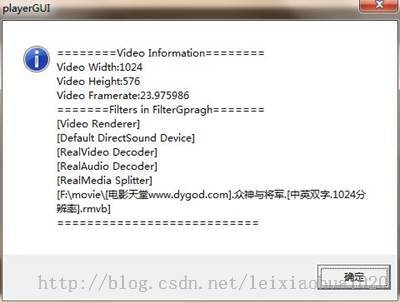最简单的基于DirectShow的示例:视频播放器图形界面版
=====================================================
最简单的基于DirectShow的示例文章列表:
最简单的基于DirectShow的示例:视频播放器
最简单的基于DirectShow的示例:视频播放器图形界面版
最简单的基于DirectShow的示例:视频播放器自定义版
最简单的基于DirectShow的示例:获取Filter信息
=====================================================
本文记录一个最简单的基于DirectShow的图形界面的视频播放器。基于DirectShow的图形界面的播放器的例子还是比较多的,但是大部分都是“层层封装”的例子。“层层封装”的例子相对来说更加稳定,但是却不是很容易理解。因为DirectShow本身的接口函数的数量就比较多,如果再加上封装DirectShow的函数,合起来的函数数量是非常大的,很容易让人搞不清哪些才是真正的DirectShow接口函数。本播放器剥去了DirectShow例子中的“层层封装”,直接调用DirectShow的接口完成视频的播放工作,更加适合DirectShow入门使用。
几个功能的实现机制
整个工程的代码比较多,不再详细记录。在这里简单记录一下代码中的几个关键点。视频的播放/暂停/继续/停止
播放
视频“播放”的源代码如下所示。简单来说,完成了以下视频播放的初始化工作:(1) 输入的URL转换为Unicode编码(RenderFile()函数支持的输入是Unicode字符串)。
(2) 调用RenderFile()“智能”创建Filter Graph。
(3) 调用IMediaControl的Run()方法开始播放视频。
(4) 开启定时器,用于更新视频播放的进度(后文详细记录)
void CplayerGUIDlg::OnBnClickedStart()
{
CStringA cstr_urla;
CStringW cstr_urlw;
HRESULT hr;
//Render
#ifdef _UNICODE
m_url.GetWindowText(cstr_urlw);
#else
USES_CONVERSION;
m_url.GetWindowText(cstr_urla);
cstr_urlw.Format(L"%s",A2W(cstr_urla));
#endif
if(cstr_urlw.IsEmpty()){
AfxMessageBox(_T("Input URL is NULL!"));
return;
}
hr = pGraph->RenderFile(cstr_urlw, NULL);
if(FAILED(hr)){
AfxMessageBox(_T("Can't open input file!"));
return;
}
//Set Window
HWND screen_hwnd=NULL;
RECT windowRect;
screen_hwnd = this->GetDlgItem(IDC_SCREEN)->GetSafeHwnd();
::GetClientRect(screen_hwnd, &windowRect);
pWindow->put_Visible(OAFALSE);
pWindow->put_Owner((OAHWND)screen_hwnd);
pWindow->put_Left(0);
pWindow->put_Top(0);
pWindow->put_Width(windowRect.right - windowRect.left);
pWindow->put_Height(windowRect.bottom - windowRect.top);
pWindow->put_WindowStyle(WS_CHILD|WS_CLIPCHILDREN|WS_CLIPSIBLINGS|WS_THICKFRAME);
pWindow->put_MessageDrain((OAHWND) screen_hwnd);//Receive Message
pWindow->put_Visible(OATRUE);
pEvent->SetNotifyWindow((OAHWND)screen_hwnd, WM_GRAPHNOTIFY, 0);
// Run
hr = pControl->Run();
playerstate=STATE_PLAY;
SetBtn(STATE_PLAY);
SetTimer(1,1000,NULL);
}
暂停/继续
视频“暂停/继续”的源代码如下所示。其中调用了IMediaControl的Pause()和Run()设定“暂停”或者是“继续”。void CplayerGUIDlg::OnBnClickedPause()
{
HRESULT hr;
if(playerstate==STATE_PLAY){
hr=pControl->Pause();
playerstate=STATE_PAUSE;
GetDlgItem(ID_PAUSE)->SetWindowText(_T("Resume"));
}else if(playerstate==STATE_PAUSE){
hr=pControl->Run();
playerstate=STATE_PLAY;
GetDlgItem(ID_PAUSE)->SetWindowText(_T("Pause"));
}
}
停止
视频的“停止”的源代码如下所示。该部分代码完成了以下工作:(1) 把播放的位置重新调整为0
(2) 调用IMediaControl的Pause()
(3) 关闭定时器
(4) 删除Filter Graph中的Filter
void CplayerGUIDlg::OnBnClickedStop()
{
long long position = 0;
HRESULT hr;
hr = pSeeking->SetPositions(&position, AM_SEEKING_AbsolutePositioning | AM_SEEKING_SeekToKeyFrame,
0, AM_SEEKING_NoPositioning);
KillTimer(1);
hr=pControl->Stop();
// Enumerate the filters And remove them
IEnumFilters *pEnum = NULL;
hr = pGraph->EnumFilters(&pEnum);
if (SUCCEEDED(hr))
{
IBaseFilter *pFilter = NULL;
while (S_OK == pEnum->Next(1, &pFilter, NULL))
{
// Remove the filter.
pGraph->RemoveFilter(pFilter);
// Reset the enumerator.
pEnum->Reset();
pFilter->Release();
}
pEnum->Release();
}
SystemClear();
}
视频播放进度在时间轴的显示
随着视频的播放,需要在视频播放进度的时间轴上更新播放进度信息。在程序中使用了一个定时器完成这个功能。在视频开始播放的时候,调用SetTimer()开启定时器。时间间隔设置为1000ms。
SetTimer(1,1000,NULL);在视频停止播放的时候,调用KillTimer()结束定时器。
KillTimer(1);在定时器的消息响应函数中,调用了IMediaSeeking的GetCurrentPosition()获取视频当前播放到的时间,调用了IMediaSeeking的GetDuration ()获取视频的时长。根据以上函数得到的数值,计算后把结果设置到相应的控件上。这部分的代码如下所示。
void CplayerGUIDlg::OnTimer(UINT_PTR nIDEvent)
{
if (nIDEvent == 1){
CString curtimestr,durationstr;
long long curtime;
long long duration;
int tns, thh, tmm, tss;
int progress;
//ms
pSeeking->GetCurrentPosition(&curtime);
if(curtime!=0){
//change to second
tns = curtime/10000000;
thh = tns / 3600;
tmm = (tns % 3600) / 60;
tss = (tns % 60);
curtimestr.Format(_T("%02d:%02d:%02d"),thh,tmm,tss);
m_curtime.SetWindowText(curtimestr);
}
pSeeking->GetDuration(&duration);
if(duration!=0){
tns = duration/10000000;
thh = tns / 3600;
tmm = (tns % 3600) / 60;
tss = (tns % 60);
durationstr.Format(_T("%02d:%02d:%02d"),thh,tmm,tss);
m_duration.SetWindowText(durationstr);
progress=curtime*100/duration;
m_progress.SetPos(progress);
}
}
CDialogEx::OnTimer(nIDEvent);
}
视频播放点的调整
当鼠标拖动滑动控制条(Slider Control)控件上的滑块的时候,需要根据拖动的位置设置视频的播放进度。此时调用IMediaSeeking的SetPositions()设定视频的播放进度。消息响应函数中的代码如下所示。void CplayerGUIDlg::OnHScroll(UINT nSBCode, UINT nPos, CScrollBar* pScrollBar)
{
if (pScrollBar->GetSafeHwnd() == m_progress.GetSafeHwnd()){
float pos_bar=0.0;
long long duration=0.0;
long long pos_time=0.0;
if(nSBCode==SB_THUMBPOSITION){
pos_bar=(float)nPos/100.0;
pSeeking->GetDuration(&duration);
pos_time=pos_bar*duration;
long long position = (long long)(pos_time);
HRESULT hr = pSeeking->SetPositions(&position, AM_SEEKING_AbsolutePositioning | AM_SEEKING_SeekToKeyFrame,
0, AM_SEEKING_NoPositioning);
}
}
CDialogEx::OnHScroll(nSBCode, nPos, pScrollBar);
}
“全屏播放”的问题
视频的全屏播放通过IVideoWindow的put_FullScreenMode()实现,代码如下所示。void CplayerGUIDlg::OnBnClickedFullscreen()
{
pWindow->put_FullScreenMode(OATRUE);
}
同时,在“全屏模式”启动后,如果按“ESC”键的话,可以关闭“全屏模式”。这部分的代码在PreTranslateMessage()中实现,如下所示。
//Exit Full Screen mode when push "ESC"
BOOL CplayerGUIDlg::PreTranslateMessage(MSG* pMsg)
{
if (pMsg->message == WM_KEYDOWN){
if (pMsg->wParam == VK_RETURN || pMsg->wParam == VK_ESCAPE){
// Restore form fullscreen mode
pWindow->put_FullScreenMode(OAFALSE);
return 1;
}
}
return CDialogEx::PreTranslateMessage(pMsg);
}
在这里有一点需要注意,IVideoWindow的put_FullScreenMode()在Win7下是有问题的。只有在设置窗口样式的的时候,在样式中指定WS_THICKFRAME后才可以正常使用。例如如下代码。
pWindow->put_WindowStyle(WS_CHILD|WS_CLIPCHILDREN|WS_CLIPSIBLINGS|WS_THICKFRAME);如果没有指定WS_THICKFRAME样式的话,在退出“全屏”模式之后,视频就显示不出来了,取而代之的是一片黑色。
但是设定WS_THICKFRAME样式之后,视频窗口的外围会有一层“白边”,会影响到视频显示的美观。因此我们如果希望正常使用全屏的话,可能需要找一种更好的方法,在这里我就没有深入研究了。
运行结果
这是使用DirectShow基于MFC开发的一个示例播放器。实现了一个播放器的基本功能:播放,暂停/继续,停止,播放时间轴的显示,以及从任一点开始播放媒体。并且支持将媒体文件拖拽至播放器进行播放。播放前将媒体文件的路径输入到“URL”栏中,然后单击“Start”即可开始播放。在软件下方包含了“start”,“Pause”,“Stop”等按钮用于控制媒体的播放。
播放时候的效果截图如下所示。
单击“Full Screen”可以全屏播放。单击“Info”可以显示正在播放媒体的信息,包括以下两种信息:(1) 该视频的相关信息
(2) 播放该视频的 Filter Graph中的Filter。
下载
Simplest DirectShow Example
项目主页
SourceForge:https://sourceforge.net/projects/simplestdirectshowexample/
Github:https://github.com/leixiaohua1020/simplest_directshow_example
开源中国:http://git.oschina.net/leixiaohua1020/simplest_directshow_example
CDSN下载地址: http://download.csdn.net/detail/leixiaohua1020/8348163
本程序包含了DirectShow开发的示例程序。适合DirectShow初学者进行学习。
它包含了以下几个子程序:
simplest_directshow_player: 最简单的基于DirectShow的视频播放器。
simplest_directshow_player_custom: 最简单的基于DirectShow的视频播放器(Custom)。
playerGUI: 最简单的基于DirectShow的播放器-图形界面版。
simplest_directshow_info: 最简单的Directshow信息显示例子。
simplest_directshow_filter: 目前还未完成。



